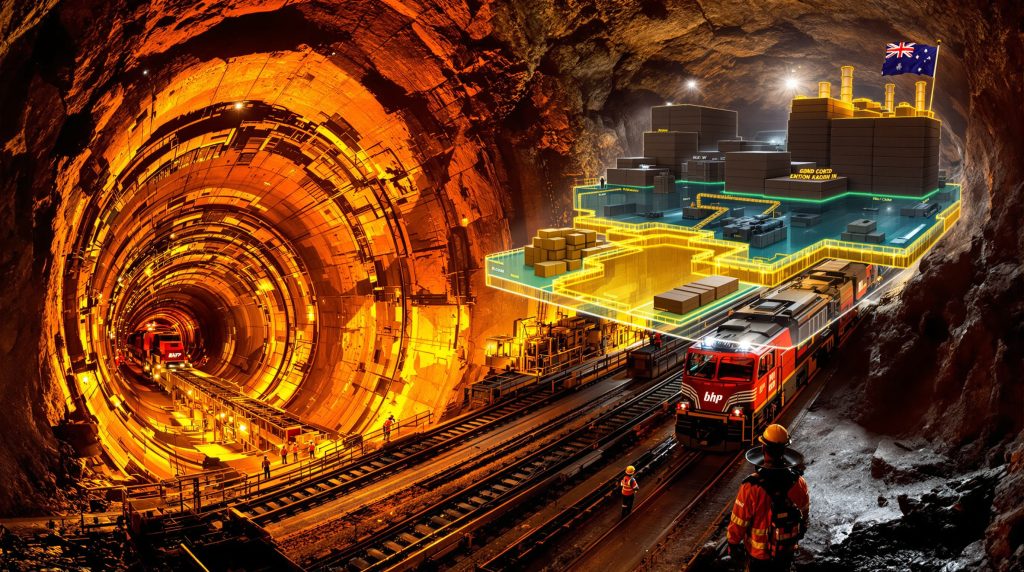BHP's Olympic Dam Investment: Strategic Expansion and Growth Potential
BHP has announced a significant $840 million investment package for its Olympic Dam operation in South Australia. This strategic funding aims to strengthen underground mining productivity and expand the site's copper processing capabilities. The investment represents one of the most substantial commitments to the operation in recent years and signals BHP's confidence in the long-term value of this multi-mineral asset.
Key Components of the $840 Million Investment
The investment package includes several critical infrastructure improvements designed to enhance both mining and processing operations:
- Construction of a new underground access tunnel to the Southern Mine Area
- Implementation of an advanced backfill delivery system
- Expansion of ore pass capacity with streamlined handling procedures
- Extension of the underground electric rail network by 1.15km
- Addition of new locomotives to the underground fleet
- Installation of a new oxygen plant to enhance smelter performance
How Will This Investment Transform Olympic Dam's Operations?
The strategic funding will fundamentally change Olympic Dam's operational capabilities across multiple dimensions, from underground mining to processing capacity.
Underground Mining Enhancements
The new underground access tunnel will provide critical entry to previously untapped sections of the resource. This strategic development opens up fresh mining fronts and creates opportunities for increased production volumes from areas that were previously inaccessible.
The backfill system represents a significant technological advancement for the operation. By delivering paste fill via underground pipeline to new areas of the mine, BHP can access sections of the ore body that were previously difficult to reach. This innovation effectively expands the operational footprint without requiring entirely new mine development, maximizing resource extraction from the existing infrastructure.
Transportation and Logistics Improvements
The expanded underground electric rail network, with its additional 1.15km of track and new locomotives, will transform material movement throughout the operation. This upgrade delivers multiple operational benefits that enhance both efficiency and sustainability:
- Reduced reliance on diesel truck haulage within the underground environment
- Lower emissions from underground operations, improving air quality and working conditions
- Improved safety conditions for workers through reduced vehicle interactions
- Enhanced operational efficiency and productivity with more reliable material transport
- Decreased maintenance requirements compared to truck fleets, reducing downtime
Processing Capacity Expansion
The new oxygen plant represents a critical component of BHP's smelter debottlenecking program. This facility will boost concentrate smelting rates from the current 80 tonnes per hour to 85 tonnes per hour—a 6.25% increase in processing capacity that will have significant impacts on overall production volumes.
The oxygen plant plays a crucial role in the metallurgical process by:
- Facilitating the separation of sulfur and iron impurities from copper concentrate
- Supporting the creation of blister copper at 99% purity levels
- Enabling the final casting of copper anodes for refinement into copper cathode, gold, and silver
What is Olympic Dam's Production Potential?
Olympic Dam's strategic importance to BHP's portfolio continues to grow as the company positions itself to capitalize on increasing global demand for copper and uranium investment.
Current Production Profile
Olympic Dam has demonstrated consistent performance in recent years, delivering over 300,000 tonnes of copper annually for the past three consecutive years. This stability provides BHP with a solid foundation upon which to build its expansion plans, showing the reliability of the operation even before these new investments.
The mine's consistent production levels reflect BHP's operational expertise and the inherent quality of the Olympic Dam resource. Few mines globally can maintain such stable production volumes over multiple years, highlighting the operation's world-class status.
Growth Trajectory
According to BHP Chief Operating Officer Edgar Basto, these strategic projects will contribute to growing the South Australian copper province's annual copper base from the current 1.7 million tonnes to an ambitious 2.5 million tonnes—representing a 47% increase in production potential.
This growth trajectory aligns with increasing global demand for copper, particularly driven by several key sectors:
- Renewable energy infrastructure development requiring extensive copper wiring and components
- Electric vehicle manufacturing expansion, with each vehicle requiring 3-4 times more copper than conventional vehicles
- Grid modernization projects worldwide as electricity systems adapt to new generation sources
- Consumer electronics production growth continuing to drive baseline copper demand
The timing of BHP's investment is particularly strategic given copper's critical role in the global energy transition and the forecasted supply deficits in coming years, as highlighted in recent copper price insights.
Why is BHP Investing in Copper Production?
BHP's substantial investment in Olympic Dam reflects both market-driven strategy and the unique characteristics of this world-class resource.
Strategic Market Positioning
Copper represents one of the most critical metals for the global energy transition. As economies worldwide accelerate decarbonization efforts, copper demand is projected to grow significantly due to its essential role in:
- Solar and wind power generation systems requiring extensive copper wiring
- Electric vehicle manufacturing (requiring 3-4 times more copper than conventional vehicles)
- Energy storage technologies utilizing copper components for efficiency and safety
- Transmission infrastructure upgrades needed to support renewable energy integration
Industry forecasts suggest that copper demand could outpace supply within this decade, creating favorable pricing conditions for major producers like BHP. The International Copper Association projects that copper demand will increase by more than 50% by 2040, driven primarily by renewable energy and electrification initiatives.
Olympic Dam's Unique Multi-Mineral Value
Unlike many copper operations globally, Olympic Dam offers a diversified production profile that includes:
- Copper as the primary product driving investment decisions
- Gold as a valuable by-product enhancing overall economics
- Silver as an additional revenue stream providing market exposure
- Uranium as a strategic energy mineral with growing importance in low-carbon energy generation
This multi-mineral nature provides BHP with revenue diversification and protection against single-commodity price volatility. When copper prices fluctuate, the value of gold, silver, and uranium can help stabilize overall returns from the operation, a factor increasingly important in gold market analysis.
| Mineral | Role at Olympic Dam | Market Significance |
|---|---|---|
| Copper | Primary product | Critical for electrification and renewable energy |
| Gold | Valuable by-product | Safe-haven asset with consistent demand |
| Silver | Secondary by-product | Industrial and investment applications |
| Uranium | Strategic mineral | Low-carbon baseload power generation |
How Does This Investment Compare to Previous Olympic Dam Developments?
BHP's approach to Olympic Dam has evolved over time, with the current investment representing a more measured and targeted strategy compared to earlier proposals.
Historical Investment Context
BHP has demonstrated a pattern of strategic investment in Olympic Dam over recent years:
| Year | Investment Amount | Focus Areas |
|---|---|---|
| FY2018 | A$600+ million | Underground infrastructure, processing facilities |
| FY2018 | A$350 million | Major smelter upgrade campaign |
| 2025 | A$840 million | Underground productivity, smelter expansion |
The current investment package represents the largest single commitment to Olympic Dam's development in recent years, signaling BHP's increasing confidence in the operation's long-term value proposition. This approach contrasts with the company's earlier strategies, which included a proposed massive open-pit expansion that was later shelved in favor of more incremental improvements.
The company's shift toward targeted underground enhancements reflects a more capital-efficient approach to growth, focusing on high-return projects with shorter implementation timelines rather than decade-long mega-projects, as detailed in BHP's Olympic Dam investment announcement.
Broader Expansion Vision
Beyond the current $840 million package, BHP has proposed a significant expansion of smelting and refining activities at Olympic Dam, with plans to:
- Increase copper cathode production from 200,000 tonnes to 650,000 tonnes annually
- Construct a second smelter furnace to process additional concentrate
- Repurpose existing facilities for enhanced processing efficiency
- Build additional water supply infrastructure to support expanded operations
- Upgrade electricity transmission capacity to meet increased power requirements
These longer-term plans would position Olympic Dam among the world's premier copper operations, with integrated mining, processing, and refining capabilities all located at a single site—an increasingly rare configuration in the global mining industry.
What Are the Economic Implications for South Australia?
BHP's investment strengthens South Australia's position in the global minerals sector and delivers significant regional economic benefits.
Regional Economic Benefits
The investment strengthens South Australia's position as a global copper production hub and delivers multiple economic benefits:
- Creation of construction jobs during development phases of the various projects
- Sustained mining employment opportunities in a region dependent on resource development
- Support for local suppliers and service providers throughout the mining supply chain
- Increased royalty payments to the state government from expanded production
- Enhanced export revenues boosting Australia's trade balance
For South Australia specifically, the Olympic Dam expansion reinforces the state's reputation as a mining-friendly jurisdiction capable of attracting major capital investments from global resources companies. This reputation helps attract additional investments in both mining and related sectors.
Supply Chain Significance
Olympic Dam's expansion contributes to Australia's critical minerals strategy by:
- Strengthening domestic copper production capabilities at a time of increasing demand
- Supporting downstream manufacturing opportunities in copper refining and processing
- Enhancing supply chain resilience for critical minerals essential to advanced manufacturing
- Positioning Australia as a reliable supplier in global markets increasingly concerned about secure mineral supplies
The security of supply for critical minerals like copper has become a strategic priority for many nations, particularly as geopolitical tensions increase competition for these essential resources. BHP's investment in Olympic Dam helps cement Australia's position as a trusted supplier to key allies and trading partners, with uranium market trends also playing an important role in this dynamic.
What Challenges Must BHP Navigate?
Despite the significant investment and promising outlook, BHP faces several challenges in maximizing the value of Olympic Dam.
Operational Considerations
Despite the significant investment, BHP faces several challenges in executing its Olympic Dam strategy:
- Managing water access in South Australia's arid environment, particularly as production increases
- Securing reliable and affordable energy for expanded operations amid Australia's energy transition
- Maintaining environmental compliance during expansion while minimizing ecological impacts
- Balancing capital allocation across its global portfolio of competing investment opportunities
- Navigating potential uranium export restrictions and regulations affecting that portion of production
The water challenge is particularly significant, as mining operations require substantial water resources in a region where this is a scarce commodity. BHP has invested in desalination capacity and water recycling technologies to address this constraint, but further expansion may require additional solutions.
Environmental Context: Olympic Dam operates in an environmentally sensitive arid region, requiring careful management of water resources, waste materials, and rehabilitation planning. BHP must balance production growth with increasingly stringent environmental expectations.
Market Dynamics
The success of BHP's Olympic Dam investment will be influenced by:
- Long-term copper price trajectories as global supply and demand fundamentals evolve
- Global competition from new copper projects coming online in Chile, Peru, and other regions
- Production costs relative to industry benchmarks determining competitive positioning
- Technological innovations in mining and processing that could disrupt conventional operations
- Regulatory developments in mining and environmental policy affecting operational parameters
Copper market dynamics will play a central role in determining the ultimate return on BHP's investment. While current forecasts suggest strong demand growth, the timing and scale of new supply from competing projects could impact price realizations during Olympic Dam's expansion ramp-up, as analysed in the comprehensive investment strategies guide.
FAQ: BHP's Olympic Dam Investment
How will the new oxygen plant improve Olympic Dam's operations?
The oxygen plant will increase smelter efficiency by improving the separation of sulfur and iron impurities from copper concentrate. This metallurgical enhancement will boost smelting rates from 80 to 85 tonnes per hour and support higher overall production volumes, addressing a key processing bottleneck in the operation.
What makes Olympic Dam unique among copper mines?
Olympic Dam stands out for its polymetallic nature, producing copper, gold, silver, and uranium from a single ore body. This diversity provides operational flexibility and revenue diversification that most copper-only operations cannot match. Additionally, its status as one of the world's largest known copper deposits ensures decades of production potential.
How does this investment align with global energy transition goals?
By expanding copper production, BHP is positioning itself to meet growing demand from renewable energy, electric vehicles, and grid modernization projects—all critical components of global decarbonization efforts. Copper's excellent conductivity makes it essential for efficient electricity transmission, a cornerstone of reduced carbon emissions across multiple sectors.
What is the timeline for implementing these new projects?
While BHP has not disclosed specific completion dates for each component, infrastructure investments of this scale typically require 2-3 years for full implementation and operational integration. The company will likely phase in the various enhancements sequentially to minimize disruption to ongoing operations while systematically increasing capacity.
Further Exploration
Olympic Dam's expansion represents just one element of Australia's growing importance in the global critical minerals supply chain. The country's rich endowment of copper, lithium, nickel, and rare earth elements positions it as a key supplier for the energy transition and advanced manufacturing sectors.
BHP's investment strategy at Olympic Dam reflects the company's broader shift toward "future-facing" commodities that will see increased demand as the world moves toward lower-carbon technologies. Similar investments across their portfolio show a consistent approach to positioning for long-term growth in minerals critical to technological advancement and energy transformation.
Readers interested in learning more about Australian mining developments can also explore related educational content from Australian Mining, which offers additional perspectives on mining operations and investments in Australia.
Ready to Capitalise on the Next Major Mining Discovery?
Stay ahead of the market with real-time alerts on significant ASX mineral discoveries powered by Discovery Alert's proprietary Discovery IQ model, transforming complex mineral data into actionable investment insights just like BHP's strategic expansions at Olympic Dam. Explore why major mineral discoveries can lead to substantial returns by visiting Discovery Alert's dedicated discoveries page.




